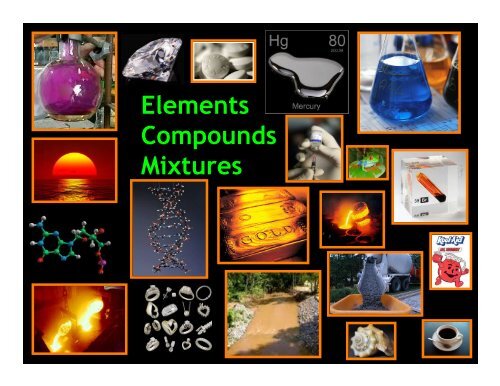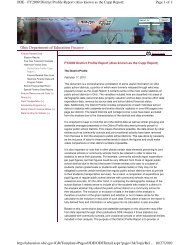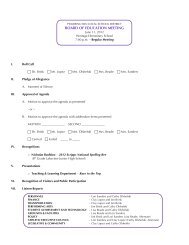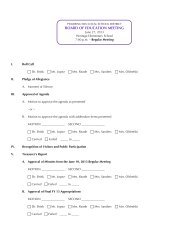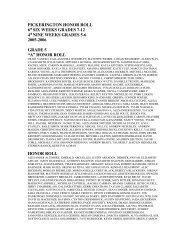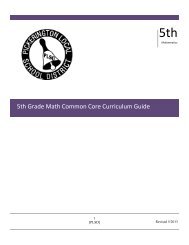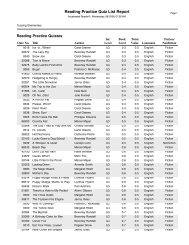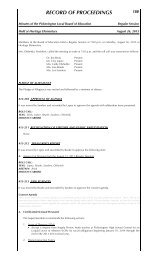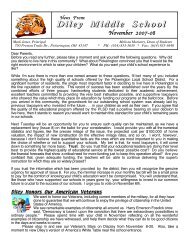Elements Compounds Mixtures
Elements Compounds Mixtures
Elements Compounds Mixtures
- No tags were found...
Create successful ePaper yourself
Turn your PDF publications into a flip-book with our unique Google optimized e-Paper software.
<strong>Elements</strong><strong>Compounds</strong><strong>Mixtures</strong>
<strong>Mixtures</strong> - <strong>Elements</strong> - <strong>Compounds</strong>Chemists like to classify things.One way that chemists classify matter is by its composition.All matter can be classified as mixtures, elements and compounds.1. All matter is composed of atoms and groups of atomsbonded together, called molecules.A. Substances that are made from more than one typeof atom bonded together are called compounds.B. <strong>Compounds</strong> and elements that are combinedphysically, but not chemically, are called mixtures.
Chemists can classify matter into-<strong>Mixtures</strong> Two or more substances that are not chemically combinedwith each other- they are mixed together.<strong>Mixtures</strong> can be separated by physical means.The “things” in a mixture keep their individual properties.<strong>Elements</strong> Simplest form of pure substance.They cannot be broken down into anything else byphysical or chemical means.<strong>Compounds</strong> Pure substances that are composed of two or moreelements chemically bonded together.<strong>Compounds</strong> can be broken into simpler substances by chemical means.
Classifying MatterMatterPure Substances<strong>Mixtures</strong>HomogeneousHeterogeneous<strong>Elements</strong><strong>Compounds</strong>Not UniformThroughoutOn Periodic TableHave a SymbolHave a Formula
<strong>Mixtures</strong> and Pure Substances1. A mixture has unlike parts and a composition that variesfrom sample to sample.2. A heterogeneous mixture has physically distinct parts withdifferent properties, non-uniform throughout.3. A homogeneous mixture is the same throughout the sample.4. Pure substances are substances with a fixed composition.<strong>Elements</strong> and <strong>Compounds</strong> ARE pure substances.
<strong>Elements</strong>1. Science has come along way since theGreek Theory of all matter composed of-Air-Water- Fire-Earth2. Chemists have identified 90 naturallyoccurring elements, and syntheticallyproduced about +28 others.1. An element is made of one kind of atom2. Found on the Periodic Table3. All elements are made of atoms.4. Atoms of the same element are alike.5. Atoms of different elements are different.
Three Types of <strong>Elements</strong>1. Metals Solids, malleable, ductile, goodconductors, mercury the only liquid atroom temperature. Largest group ofelements.2. Nonmetals Solids and gases, brittle, poorconductors. Bromine the only liquidat room temperature.3. Metalloids Share properties of both. Smallestgroup of elements.
Properties of Metalsmalleable1. Metals are good conductorsof heat and electricity.2. Metals are shiny, metallicluster.malleable3. Metals are ductile (can bestretched into thin wires).4. Metals are malleable (canbe pounded into sheets).5. A chemical property ofmetal is its reaction withwater which results incorrosion.ductile
Properties of Non-Metals1. Non-metals are poor conductors ofheat and electricity.Sulfur2. Non-metals are not ductile ormalleable.3. Solid non-metals are brittle andbreak easily.4. They are dull.5. Many non-metals are gases.
Properties of Metalloids1. Metalloids (metal-like) have propertiesof both metals and non-metals.2. They are solids that can be shiny ordull.3. They conduct heat and electricitybetter than non-metals but not as wellas metals.4. They are ductile and malleable.SiliconThe most important metalloidfor its use in computer chips
The elements of- Aluminum, Iron, Oxygen, and Silicon makeup about 88% of the earth's solid surface.Water on the surface and in the air as clouds and fog is madeup of hydrogen and oxygen.The air is 99% nitrogen and oxygen.Hydrogen, oxygen, and carbon make up 97% of a person.Thus almost everything you see in this picture us made up ofjust six elements.
What Is A Compound?1. A compound is a pure substance that is createdby two or more elements chemically reactingand bonding together.A. Ex: NaCl, H 2 O, CO 2 , NH 3 , NaHCO 3 , and C 6 H 12 O 6B. ALL compounds can be written as a FORMULA,which will show the elements present and inwhat proportion.
Types of <strong>Compounds</strong>Inorganic <strong>Compounds</strong>a) Acid Form a H + ion in solutionI. H + are chemically very reactiveII.III.IV.React with metals to form hydrogen gasStrong acids are corrosiveTaste sourCommon AcidsHCl Hydrochloric Acid - Stomach AcidH 2 SO 4 Sulfuric Acid - Car BatteryH 2 CO 3 Carbonic Acid - Soft DrinksHNO 3 Nitric AcidH 3 PO 4 Phosphoric Acid - Some Soft DrinksHC 2 H 3 O 2 Acetic Acid - Vinegar (organic acid)
Types of <strong>Compounds</strong>Inorganic <strong>Compounds</strong>b) Base Form a (OH) - ion in solutionI. (OH) - are chemically very reactiveII.III.IV.Dissolve fats and oils, makes them good cleaners/soapsHave a slippery feeling to themTaste bitterV. Strong bases are caustic (cause chemical burns)Common BasesNaOH Drano (Drain Cleaners)Al(OH) 3Ca(OH) 2Mg(OH) 2 in antacid tabletsused to help concrete set-up
Types of <strong>Compounds</strong>Inorganic <strong>Compounds</strong>c) Salt <strong>Compounds</strong> that form ions in solution, madefrom metals and nonmetalsCommon SaltsNaCl table saltKCl salt substituteCaCl 2 De-IcerCaSO 4MgSO 4Dry WallEpsom SaltIONS Atoms that have lost OR gained electrons,making them have a positive or negative charge.ORGANIC <strong>Compounds</strong>Carbon based compounds, these types ofcompounds are associated with living things.
Why Do <strong>Compounds</strong> Form?<strong>Compounds</strong> form to allow elementsto become more stable.A. Na is flammable when it comes incontact with H 2 O, and Cl 2 is a toxicgasB. NaCl is a very stable compound that isneither flammable nor toxic in normalquantities.<strong>Compounds</strong> that are extremely unstablewill break down to form the more stableelements- EXPLOSIVES!!!!SodiumChlorine
<strong>Compounds</strong>1. Sodium is an element.2. Chlorine is an element.3. When sodium andchlorine bond they makethe compound sodiumchloride, commonlyknown as table salt.<strong>Compounds</strong> have different propertiesthan the elements that make them up.Table salt has different properties than sodium, anexplosive metal, and chlorine, a poisonous gas.
What Do <strong>Compounds</strong> Have To Do With My Life?<strong>Compounds</strong> are the substances thatmake up ALL living and non-living things.
<strong>Mixtures</strong>1. Hydrogen is an element.2. Oxygen is an element.3. When hydrogen and oxygen bondthey make the compound water.4. When salt and water arecombined, a mixture is created.<strong>Compounds</strong> in mixtures retaintheir individual properties.The ocean is a mixture.
What Is a Homogenous Mixture?1. A homogeneous mixture is a mixture that is evenlydistributed- THE SAME THROUGHOUT2. Homogeneous mixtures called solutions or colloids.A. Solution = Solute + SolventI. Solute: substance being dissolvedII. Solvent: substance doing the dissolving3. The solvent is present in greater quantity4. The solute is present in the lesser quantityA. Ex: Salt water ➜ Salt = solute Water = solvent
Colloid – Homogeneous Mixture1. In a colloid the particles are mixed together butnot dissolved.2. The particles are microscopic size so they arekept permanently suspended.3. A colloid will not separate upon standing.4. The particles are constantly colliding, and thisallows a colloid to scatter light – thus colloidsoften seem cloudy.Blood isa colloid.The red bloodcells are themicroscopicparticles.
Colloids and the Tyndal EffectTyndal EffectThe microscopic particles of acolloid reflect the light thatpasses through it so you see the“beam of light”–it’s called the Tyndal Effect
Solutions - Homogeneous Mixture1. A solution is a type of homogeneous mixtureformed when one substance dissolves inanother.2. The size of the solute in a solution ion, atomor molecular, so solutions never settle –theyalways still mixed.3. Solutions never settle and solutions nevershow the Tyndal effect.
Types of SolutionsSolute SolventExampleMolten metals in metals are called alloys.An ALLOY is a solid solution.
AlloysStainless steel is a mixtureof iron and chromium.Brass is an alloy of copperand zinc.Air is a solution of oxygen and othergases dissolved in nitrogen.
Heterogeneous Mixture - Suspension1. Suspension – the solute is unevenlydistributed, has to be shaken or stirred toget a uniformity in it.2. ExamplesA. PaintB. Chex Mix: You may find a different number ofpretzels or Chex cereal in each handful;therefore, the mixture is unevenly distributedC. Italian Salad dressingD. Chocolate Milk
<strong>Compounds</strong> vs<strong>Compounds</strong>Combine in setproportions- HAVE AFORMULA<strong>Elements</strong> chemicallybonded togetherSeparatedchemically<strong>Mixtures</strong><strong>Mixtures</strong>Not chemicallycombinedCan combine in anyproportionSeparatedphysically
<strong>Elements</strong>, <strong>Compounds</strong>, and <strong>Mixtures</strong>1. <strong>Mixtures</strong> can be separated by physical means.2. <strong>Compounds</strong> can only be separated by chemical means.3. <strong>Elements</strong> are pure substances. When the subatomicparticles of an element are separated from its atom, itno longer retains the properties of that element.
Classification of MatterPure Substances1. <strong>Elements</strong> 2. <strong>Compounds</strong> 3. <strong>Mixtures</strong>a) Metals a) Inorganic a) Homogeneousb) Non-Metals i. Acid i. Solutionc) Metalloids ii. Base ii. Colloidiii. Salt b) Heterogeneousb) Organic i. Suspension


